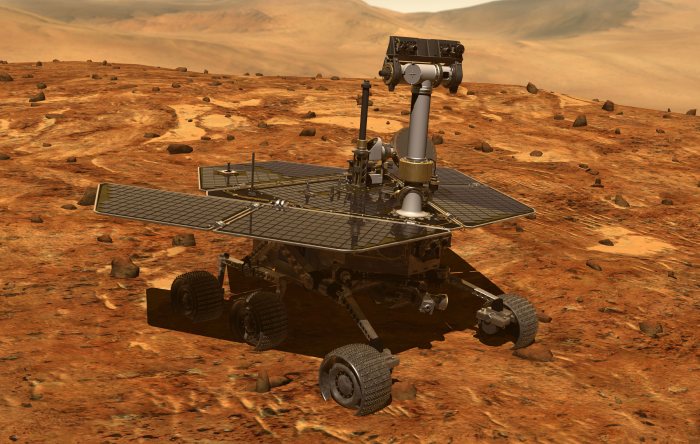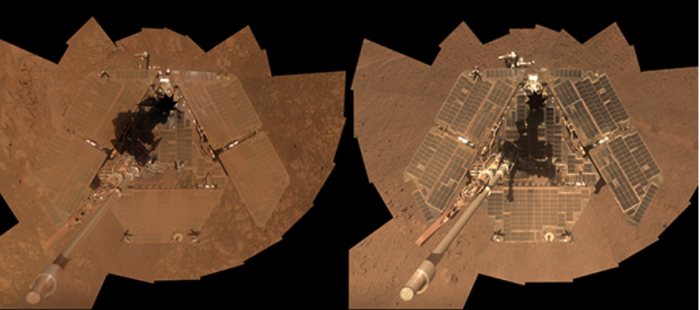
Image: NASA
For a vehicle that was only expected to last for just over 92 Earth days, NASA’s solar-powered Mars rover Opportunity has bettered even the most optimistic expectations – 14 years of active duty so far.
Opportunity landed on Mars on in January 2004, three weeks after its twin, Spirit. The rovers’ research mission was to last 90 sols1 – and NASA did not expect either of the rovers to survive their first harsh Martian winter.
Powering the rovers were solar panels expected to generate approximately 140 watts of power for up to four hours per day (560 watt-hours), assuming optimal conditions. Unlike the solar panels used for homes here on Earth, the solar cells on the rovers were based on what was at the time cutting-edge triple-junction gallium-arsenide.
The solar panels were to charge two 8-amp-hour lithium battery packs weighing approximately 7kg. Both the panels and the battery systems were expected to be heavily impacted by hostile Mars conditions and their performance to drop off significantly very early on. However, early in the mission, the panels were cranking up to 960 watt-hours a day and even after five years, were sometimes achieving up to 840 watt-hours.
Aside from temperatures that can drop to -96º Celsius at night, dust storms are common on Mars and covered the solar panel arrays on multiple occasions. The only thing to clean them off has been wind. The following image is a “selfie” of Opportunity’s solar panels before and after a cleaning event2 in 2014.

Image : NASA
The solar + energy storage system performance and the NASA team’s ability to work with the conditions on Mars were certainly above and beyond, but Spirit eventually struck problems with mobility after being caught in a “sand trap”. Not only was it stuck, it prevented NASA being able to position Spirit for adequate solar generation. Communications ceased on March 22, 2010, but its mission lasted 20 times longer than originally designed.
Opportunity has continued to soldier on to many more accomplishments, including seeing its 5,000th Martian dawn on the weekend – the following image from the rover is its 4,999th dawn.

Image: NASA
“We’ve reached lots of milestones, and this is one more, but more important than the numbers are the exploration and the scientific discoveries,” said Opportunity Project Manager John Callas, from NASA’s Jet Propulsion Laboratory, Pasadena, California.
Some of those discoveries can be viewed here.
The mission has not only demonstrated human ingenuity, but just how robust solar power and energy storage technology can be. If you’re interested in keeping up to date with Opportunity’s progress, the Mars Exploration Rovers home page is here.
Footnotes
- a Martian sol is around 40 minutes longer than an Earth day ↩
- While on the topic of dust and solar PV, pick up some solar panel cleaning tips for rooftop solar power systems here on Earth. ↩

 RSS - Posts
RSS - Posts



It is interesting that even the dopey yanks (well they picked Chump to be their President, didn’t they?) were able, 15 years ago (or thereabouts, depending on when the vehicle was assembled before starting its long journey to get there), to produce a photovoltaic system that lasted this long, “14 years of active duty so far”, in the slightly harsher Martian conditions, and, still be working, while our rooftop photovoltaic system, installed in the slightly less harsh Perth metropotian area conditions (we are about 30-40km from the nearest beach, so seaspray is not a problem here – more likely fallout from fires), died in less than four years, with no applicable warranty coverage.
Sold in Australia = faecal matter.
A solution to the problems of warranties in Australia, not being worth the paper on which they are written, and, to photovoltaic systems being a gamble, as to whether they will last long enough to pay for themselves, is, given that the Australian Consumer Law is not concerned with consumer protection, forthe establishment of industry-based warranty protection, as follows.
The industry establishes an industry-based warranty scheme, that guarantees warranty coverage. Each retailer/installer pays into the scheme, a premium, that is determined according to the risk involved with each transaction – the work done, the risk of repairs/replacement of the particular equipment (so, actuaries determine the risk associated with each brand and model of equipment, including when and where it is manufactured) installed, and the risk of correction needed to be performed, for the work done on the job (so, actuaries determining the risk associated with each installer/repairer), covering the warranted lifetime of the equipment and the work done. The industry-based warranty scheme then deals with all claims (unless the installer or equipment manufacturer honours all claims, directly), where the claims are valid, replacing faulty equipment with new, warranted, equivalent capability equipment, and, correcting faulty workmanship, should it occur, and, also, covering consequential loss (such as where a system is so badly installed, that it burns a house down, destroying the house and contents).
The industry-based warranty scheme is sufficiently publicised, so that the public is aware of it, and, no government rebates can be applicable for any work or equipment obtained from people or businesses that are not part of the industry-based warranty scheme.
This should then, eliminate lack of warranty coverage ,that is caused by such things as companies/installers/repairers going out of business, being liquidated, or, being sold or having their names changed, or, transferring their legal presence outside of Australia, ending warranty obligations, and, where manufacturers have no Australian presence against which warranty claims can be made and enforced.
And, it could provide greater confidence in the industry, in Australia, especially when the dopey yanks can keep a photovoltaic system running in the harsh conditions on Mars, for at least 14 years, but, in Australia, with much less harsh conditions, a customer is lucky, if their photovoltaic system lasts for four years, and, in Australia, a customer is lucky, if the customer gets a worthwhile (including, being enforceable) warranty on their photovoltaic system.